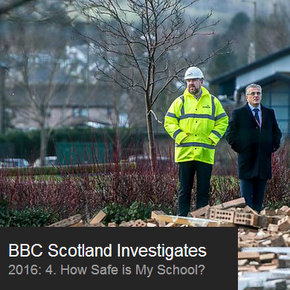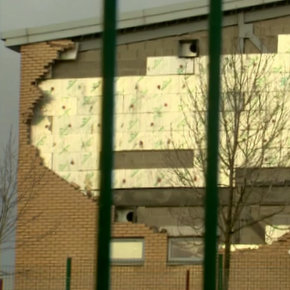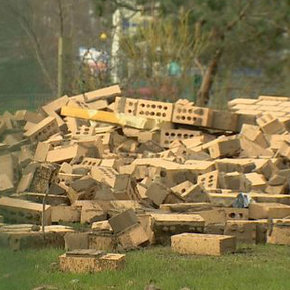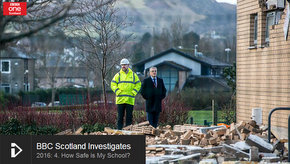
How safe are PFI schools and who made money from dangerous buildings?
 Howard Chapman, Buildingtalk Editor, reviews a new BBC investigation into the growing concern about dangerous sub-standard schools built via PFI schemes and the big profits now mostly go to offshore companies. I highly recommend you view the programme via the iPlayer link below.
Howard Chapman, Buildingtalk Editor, reviews a new BBC investigation into the growing concern about dangerous sub-standard schools built via PFI schemes and the big profits now mostly go to offshore companies. I highly recommend you view the programme via the iPlayer link below.
Under PFI, the private sector builds and manages school buildings in return for a fee, typically over 25-30 years. PFI was designed to take some public spending off the balance sheet. Was it a good investment for the taxpayer or a rip-off?
How safe is my school?
 A new BBC Scotland investigation ‘How Safe is My School?’ has revealed that 80% of the 350 PFI schools in Scotland are now owned at least partly by offshore companies. So the big PFI profits are now heading out of the UK.
A new BBC Scotland investigation ‘How Safe is My School?’ has revealed that 80% of the 350 PFI schools in Scotland are now owned at least partly by offshore companies. So the big PFI profits are now heading out of the UK.
Dexter Whitfield, from the European Services Strategy Unit, says “There are an awful lot of people making very substantial sums of money out of it” and has describes PFI projects as ‘wealth machines’.
The 17 PFI schools built in Edinburgh were closed for repairs earlier this year after problems were revealed with wall and header ties used to hold exterior and interior walls together and attach them to the rest of the building.
 The danger became apparent after part of a wall at Oxgangs Primary School collapsed. Fortunately, though children often sheltered under the wall, no child was hurt.
The danger became apparent after part of a wall at Oxgangs Primary School collapsed. Fortunately, though children often sheltered under the wall, no child was hurt.
About 7,600 primary and secondary school children were eventually affected. Local councils have assured parents that buildings affected by closures are now safe for their children to return for the start of the new school year.
An independent inquiry into the matter will consider whether the private finance method contributed to the structural issues with the buildings.
Financial scandal is growing
Under PFI deals, the private sector builds and manages school buildings in return for a fee, typically over 25-30 years. For example in one project in Edinburgh, 17 new schools were built, with the council paying £1.5m a month. It has been revealed that more than 200 PFI built schools in Scotland are at least partially owned by offshore investment funds.
Watch BBCiPlayer BBC Scotland Investigates: How Safe is My School
This includes a detailed look at the problems with wall and header ties, used to hold exterior and interior walls together and attach them to the rest of the building. Some wall ties were not properly embedded because the joints in the walls were not aligned.
Prof Alan Dunlop, Master Architect and lecturer with Robert Gordon University: “The way some of these things are done is very worrying indeed… I would suggest that it not only contravenes what would be standard practice. In my view this is malpractice”.
Thankfully, no child was killed or injured but the financial consequences from PFI will be with us for a generation. Who was responsible and have we have leant the lessons?
Your comments and insights are welcome.
Read previous Buildingtalk Blog about PFI: Bankrupt hospitals and emergency closure of 17 PFI built schools
2 comments on “How safe are PFI schools and who made money from dangerous buildings?”
Leave a Reply
You must be logged in to post a comment.
Latest news

21st February 2025
ASSA ABLOY EMEIA: Save valuable time and money with a seamless switch to programmable digital keys
In 2025, access management can be a whole lot easier. By making access part of their digital processes, businesses can put time-consuming key management and the cost of changing the locks firmly behind them. Making this switch is a lot easier than many people think, as ASSA ABLOY explains here…
Posted in Access Control & Door Entry Systems, Architectural Ironmongery, Articles, Building Industry News, Building Products & Structures, Building Services, Doors, Facility Management & Building Services, Health & Safety, Information Technology, Innovations & New Products, Retrofit & Renovation, Security and Fire Protection
21st February 2025
Showersave supports industry leaders in addressing Part L and Part G regulations
Showersave has sponsored and participated in a recent Building Insights LIVE roundtable on ‘Water & Energy Saving Innovations in New Build Housing’.
Posted in Articles, Bathrooms & Toilets, Bathrooms, Bedrooms & Washrooms, Building Associations & Institutes, Building Industry Events, Building Industry News, Building Products & Structures, Building Regulations & Accreditations, Building Services, Exhibitions and Conferences, Interiors, Pipes & Fittings, Plumbing, Retrofit & Renovation, Sustainability & Energy Efficiency
21st February 2025
GEZE: The importance of Specifying High Quality Door Closers on Fire Doors
Andy Howland, Sales & Marketing Director at GEZE UK, discusses why specifying high quality door closers on fire doors is important…
Posted in Access Control & Door Entry Systems, Accessibility, Architectural Ironmongery, Articles, Building Industry News, Building Products & Structures, Building Regulations & Accreditations, Building Services, Doors, Facility Management & Building Services, Health & Safety, Posts, Restoration & Refurbishment, Retrofit & Renovation, Security and Fire Protection
21st February 2025
Insight Data achieves ISO9001 recertification with zero non-conformities
Leading industry data specialist, Insight Data, has successfully achieved the prestigious recertification for ISO9001 with zero non-conformities for the fourth consecutive year.
Posted in Articles, Building Industry News, Building Regulations & Accreditations, Building Services, Information Technology, Research & Materials Testing


I’m not sure that just because many PFI companies have moved ‘off-shore’ means we should be all running around screaming in despair. From what another BBC program revealed about off-shore companies a while back, half the biggest PLCs in the country are ‘off-shore’ – for tax (dodging) reasons, I gather.
And just how many PFI-school walls have dramatically collapsed? 1? Again, hardly reason to be panicking…
Thanks for the comment. The offshore moves and loss of tax is just a minor irritant but the out of control PPI process is very worrying in terms of safety, quality, costs etc. Can I encourage you to watch the programme via the iPlayer link and you will see the extent of the specific problem which is more widespread than 1 school and there was considerable danger of loss of life.